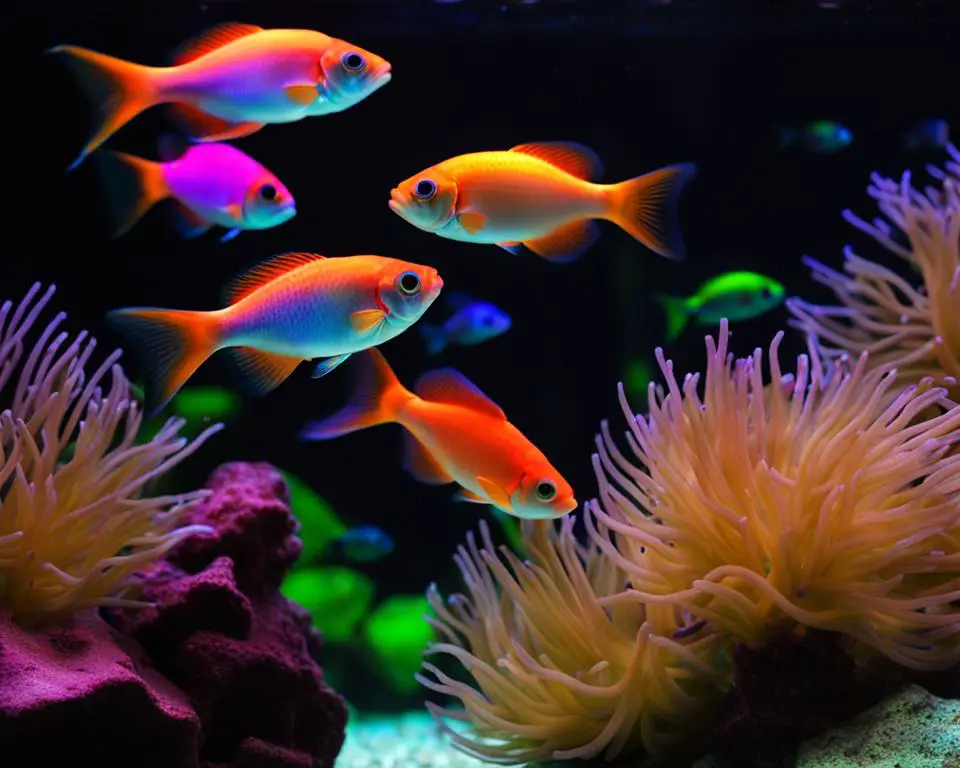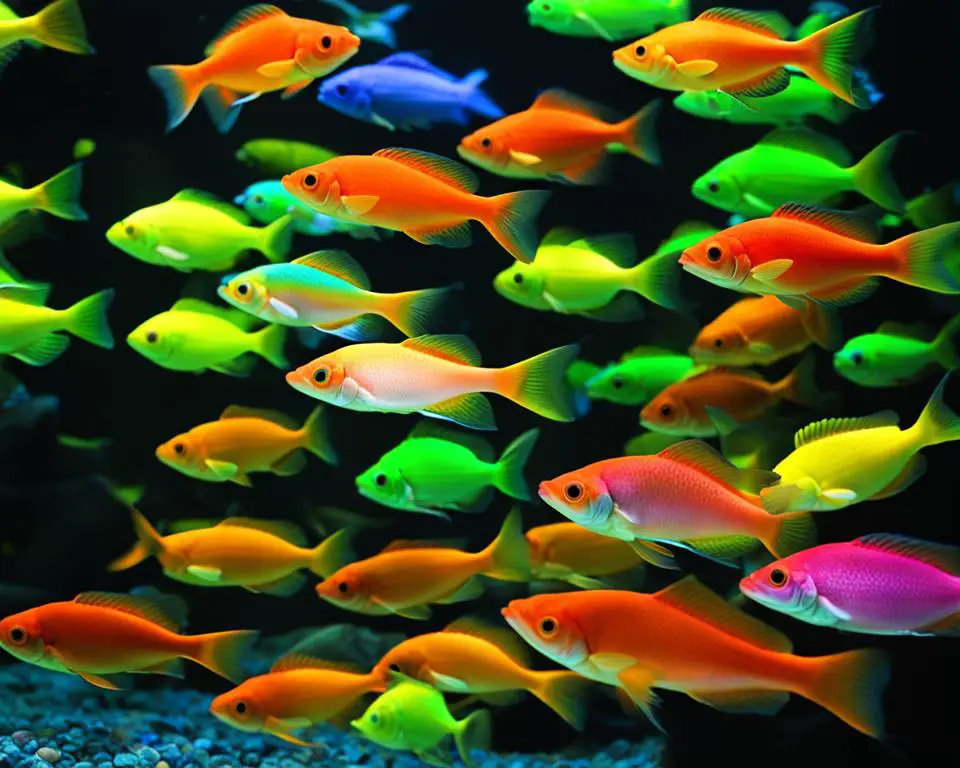As a Glofish owner, you may wonder, “Do Glofish attack each other?” The answer is not a straightforward “yes” or “no.” While Glofish are generally peaceful, their behavior can be influenced by several factors, including their tank mates, size of the tank, and feeding habits.
In this article, we will dive into the topic of Glofish aggression and help you understand their behavior. We will explore strategies to manage aggression and promote a harmonious environment for these vibrant creatures.
Key Takeaways:
- Glofish aggression levels can vary and may be impacted by several factors.
- Understanding Glofish behavior is crucial to avoid conflicts among tank mates.
- Proactive strategies can help promote a peaceful Glofish community.
Understanding Glofish Behavior
Glofish have become increasingly popular as pets due to their vibrant colors and exciting personalities. To ensure that your Glofish are happy and healthy, it’s crucial to understand their behavior and social needs. Here, I will discuss the typical behavior of Glofish in a tank setting, as well as common signs of aggression to watch out for.
Behavior with Tank Mates
Glofish are generally social creatures and can coexist peacefully with other fish species. When selecting tank mates, it’s important to choose fish with similar temperaments and care requirements. Contrasting characteristics can lead to conflicts and stress, so keep in mind the compatibility of the species before introducing them into the same environment.
A Glofish’s behavior towards its tank mates is heavily influenced by its natural instincts and hierarchy. Establishing a pecking order can manifest as chasing and biting, which may be seen particularly during breeding periods.
Aggression Signs to Watch Out For
While some chasing may be a natural behavior, excessive aggression is problematic and needs immediate attention. Signs of aggression can include biting, chasing, or fin nipping, and may result in injury or death for the targeted fish. Paying close attention to the behavior of your Glofish and addressing any instances of aggression is crucial for maintaining a harmonious tank environment.
The Importance of Observing Behavior
As a fish owner, it’s crucial to keep a close eye on the behavior of your Glofish in a communal tank. Identifying and addressing signs of aggression can help prevent conflicts, which promote a peaceful and healthy environment.
Overall, understanding the typical behavior of Glofish is vital to ensuring their well-being in the tank. Properly assessing the compatibility of species, watching for aggression signs, and monitoring their social hierarchy can promote a peaceful and enjoyable environment for both Glofish and their owners.
Managing Glofish Aggression
Preventing and managing glofish aggression requires a proactive approach to create a harmonious environment. Here are some tips to consider:
Create a Suitable Tank Set-up
Glofish need plenty of swimming space. A tank that is too small can lead to overcrowding and aggression. Ensure a minimum of 10 gallons per Glofish, and provide plenty of hiding places like plants, caves, and rocks.
Address Feeding Habits
Glofish are omnivores, but overfeeding can lead to aggressive behavior. Feed them twice a day with only as much food as they can consume in 2-3 minutes.
Choose Compatible Tank Mates
Some fish species may trigger aggressive behavior in Glofish. Avoid keeping them with slow-moving species that may get bullied or fish that have similar body colors and patterns.
Observe Behavior
Watch for signs of aggression, including chasing, nipping, biting, and fin nipping. If you see any of these behaviors, isolate the affected fish in a separate tank or rearrange the tank’s decor to disrupt territorial claims.

With the right precautions, Glofish can thrive and flourish in a peaceful tank environment. By creating a suitable tank set-up, addressing feeding habits, choosing compatible tank mates, and observing behavior, you can prevent and manage Glofish aggression.
Glofish Pecking Order and Territorial Behavior
Understanding the pecking order dynamics within a Glofish community can help prevent potential aggression and conflicts among tank mates. Each Glofish community has a hierarchy, with some fish having dominant personalities over others. The hierarchical structure is typically based on color, size, and gender.
The dominant fish in a Glofish community will have better access to food and shelter and will often occupy the prime spots in the tank. As a result, the less dominant fish may be more prone to aggression, leading to fights and injuries.
Glofish are also territorial fish, which can contribute to aggression in shared tank environments. Territorial behavior is usually linked to their natural instincts, as in their natural habitat, Glofish establish their individual territories to protect their nests and ensure their survival.
When setting up a tank for Glofish, it’s important to provide enough space and hiding spots to minimize potential conflicts. The addition of hiding spots such as PVC pipes or live plants can offer sanctuaries for less dominant fish and help reduce territorial behavior.
The use of
proper lighting and arranging tank decors is also crucial in minimizing territorial behavior and aggression in Glofish. A well-lit tank can help reduce stress levels in Glofish and, in turn, mitigate aggression issues.

| Glofish Type | Aggression Level | Compatibility with Other Glofish |
|---|---|---|
| Zebrafish | Low | Compatible with most other Glofish types |
| Starfire Red | Medium | May exhibit aggression towards smaller Glofish types |
| Electric Green | High | May exhibit aggression towards other Glofish types, especially other Electric Greens |
Table 1. Example of Glofish Types and Their Aggression Levels
Glofish aggression levels can vary depending on the species. Table 1 shows examples of different Glofish types and their aggression levels.
Glofish Aggression Signs
When determining whether Glofish are exhibiting aggressive behavior, watch out for signs such as chasing, biting, and fin nipping. These signs can indicate that one fish is choosing to target another within the community.
Other signs of aggression in Glofish include fish isolating themselves from the group, not eating, or hiding for extended periods of time. These behaviors can indicate fear or stress due to conflict within the community.
It’s essential to address any signs of aggression early to prevent potential injuries and maintain a harmonious Glofish environment.
Conclusion
Based on our exploration of Glofish behavior and aggression, we can conclude that while they are generally peaceful and compatible with other tank mates, there is a possibility of them fighting. To prevent conflicts, it’s crucial to observe their behavior and take appropriate measures such as providing adequate space, minimizing overcrowding, and avoiding overfeeding.
By addressing aggression issues promptly and creating a harmonious environment, we can ensure the well-being of our vibrant Glofish community. So, if you’re considering adding Glofish to your tank, remember to keep an eye on their behavior and provide the necessary conditions to prevent them from fighting.
FAQ
Do Glofish attack each other?
While Glofish are generally peaceful and friendly, there is a possibility of aggression among them. It’s important to understand their behavior and take necessary steps to manage any potential conflicts.
What are the signs of Glofish aggression?
Signs of Glofish aggression may include fin nipping, chasing, or territorial behavior. Aggressive Glofish may also show signs of stress, such as hiding or refusing to eat. Observing their behavior closely can help identify these signs.
How can I prevent Glofish aggression?
To prevent Glofish aggression, it is essential to provide a spacious tank with plenty of hiding spots and places for each fish to establish its territory. Additionally, maintaining proper water conditions and ensuring a balanced diet can help reduce stress and minimize aggression.
What is the pecking order among Glofish?
Glofish often establish a pecking order within their community. This means that certain individuals may be more dominant and assert their authority over others. It is essential to monitor this behavior and intervene if aggression becomes excessive or leads to harm.
How can I minimize territorial behavior among Glofish?
Minimizing territorial behavior among Glofish can be achieved by providing sufficient hiding spots and creating a well-structured tank layout. This allows each fish to have its designated area and reduces the need for aggressive displays. Additionally, maintaining a peaceful environment and avoiding overstocking can help minimize territorial conflicts.